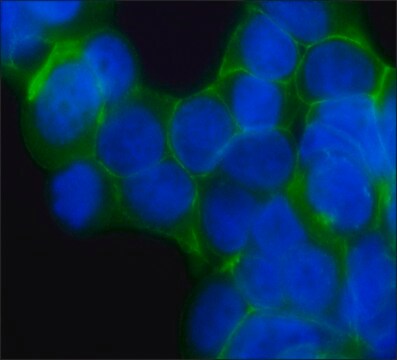詳細
Catenin beta-1 (UniProt P35222; also known as beta-Catenin) is encoded by the CTNNB1 (also known as CTNNB, MRD19) gene (ORF OK/SW-cl.35, PRO2286; Gene ID 1499) in human. beta-Catenin is a multifunctional protein involved in the regulation of cell–cell adhesion and in the control of the Wnt signaling pathway. beta-Catenin contains in its central region 12 armadillo repeats that mediate its interaction with a variety of proteins including axin, adenomatous polyposis coli (APC), and T cell factor (TCF) family transcription factors. The C-terminal domain (CTD) of beta-catenin is implicated in transcriptional functions, while the N-terminal domain (NTD) contains several posttranslational modification (ubiquitination, acetylation, and phosphorylation) sites, including the Ser33/Ser37/Thr41 residues, important for beta-catenin stability regulation. In the absence of Wnt pathway activation, beta-catenin is retained in the cytoplasm in a “destruction complex” with Axin, APC, and GSK3beta, where it is constitutively destined for proteasomal degradation as a result of constant phosphorylation by GSK3beta. Activation of the Wnt pathway results in stabilization and nuclear translocation of beta-catenin, resulting in beta-catenin target genes transcription. In addition to GSK3beta, PKCalpha is also reported to phosphorylate the Ser33/37/Thr41 residues of beta-catenin, and beta-catenin Ser45 is a known phosphorylation site for CK1alpha. In addition, HDAC6 and p300/CBP-associated factor (PCAF) regulate beta-catenin Lys49 acetylation.
特異性
Recognizes active form of β-catenin, dephosphorylated on Ser37 or Thr41.
The antibody eptiope is 100% conserved in zebrafish.
免疫原
Epitope: The epitope corresponds to amino acid residues 36-44 (HSGATTTAP) of human β-catenin.
Fusion protein corresponding to residues 1-100 of human β-catenin with a c-terminal histidine tag.
アプリケーション
Research Category
細胞骨格
Research Sub Category
接着分子(CAM)
Immunocytochemistry Analysis: A 1:100 dilution from a representative lot detected Active-β-Catenin in NIH/3T3 cells.
Flow Cytometry Analysis: 0.1 µg of this antibody from a representative lot detected Active-β-Catenin in 1X10E6 A431 and HeLa cells.
The unconjugated version (Cat. No. 05-665) has been shown to work in WB, FC, ICC, IHC, IH(P).
This Anti-Active-β-Catenin Antibody, clone 8E7, Alexa Fluor™ 647 is validated for use in Immunocytochemistry, Flow Cytometry for the detection of Active-β-Catenin.
品質
Evaluated by Immunocytochemistry in HeLa cells.
Immunocytochemistry Analysis: A 1:100 dilution of this antibody detected Active-β-Catenin in HeLa cells.
物理的形状
Protein G Purified
Purified mouse conjugate antibody in PBS with 15 mg/ml BSA and 0.1 % sodium azide.
保管および安定性
Stable for 1 year at 2-8°C from date of receipt.
その他情報
Concentration: Please refer to lot specific datasheet.
法的情報
ALEXA FLUOR is a trademark of Life Technologies
免責事項
Unless otherwise stated in our catalog or other company documentation accompanying the product(s), our products are intended for research use only and are not to be used for any other purpose, which includes but is not limited to, unauthorized commercial uses, in vitro diagnostic uses, ex vivo or in vivo therapeutic uses or any type of consumption or application to humans or animals.









